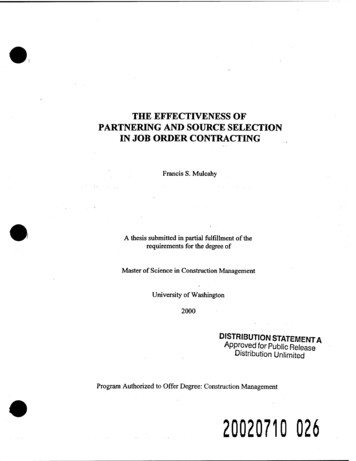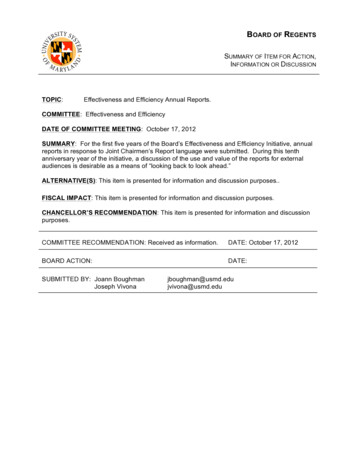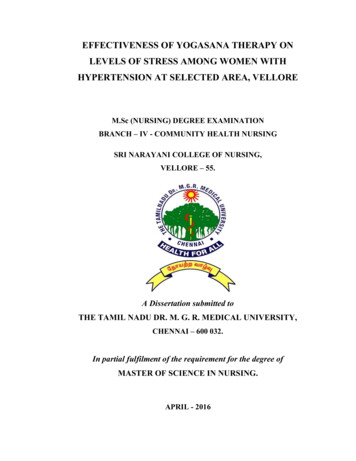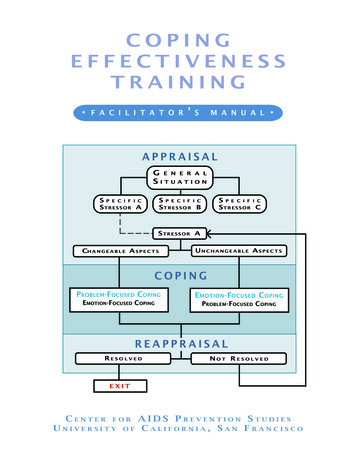
Transcription
THE EFFECTIVENESS OFPARTNERING AND SOURCE SELECTIONIN JOB ORDER CONTRACTINGFrancis S. MulcahyA thesis submitted in partial fulfillment of therequirements for the degree ofMaster of Science in Construction ManagementUniversity of Washington2000DISTRIBUTION STATEMENT AApproved for Public ReleaseDistribution UnlimitedProgram Authorized to Offer Degree: Construction Management20020710 026
3DsV)Oif if I il'1 E 0 o\ Lo0 o—mmwOz
University of WashingtonGraduate SchoolThis is to certify that I have examined this copy of a master's thesis byFrancis S. Mulcahyand have found that it is complete and satisfactory in all respects,and that any and all revisions required by the finalexamining committee have been made.Committee Members:Phillip DunstonSteve GoldblattDate: JlMg 8 J 000
In presenting this thesis in partial fulfillment of the requirements for a Master's degree atthe University of Washington, I agree that the Library shall make its copies freelyavailable for inspection. I further agree that extensive copying of this thesis is allowableonly for scholarly purposes, consistent with "fair use" as prescribed in U.S. CopyrightLaw. Any other reproduction for any purposes or by any means shall not be allowedwithout my written permission.SignatureDate0"OA C%t POOO
University of WashingtonAbstractTHE EFFECTIVENESS OFPARTNERING AND SOURCE SELECTIONIN JOB ORDER CONTRACTINGFrancis S. MulcahyChairperson of the Supervisory Committee:Professor John E. SchaufelbergerDepartment of Construction ManagementJob Order Contracting (JOC) is an alternative to the sealed bid method of procuringfacility construction and repair services. The concept was developed by the FederalGovernment in the 1980s to reduce the processing time and administrative effortrequired for smaller construction jobs. A typical JOC contract is two to five years induration and work is issued through individual delivery orders, with cost determined bypre-negotiated unit prices for a myriad of tasks. However, there are various methods thatJOC contracts are procured and administered. Due to the need for negotiations onindividual delivery orders and the lack of a defined scope of work at thebeginning of thecontract, teamwork and frequent communication are required for a successful contract.A formal Partnering process is often used in JOC to focus the parties in that direction. Inaddition, many JOC contracts employ a negotiated source selection procedure to choosea qualified contractor instead of using a sealed bid method.Research was conducted to examine the effectiveness of Partnering and source selectionprocedures to determine if their use enhances success of JOC. Thirty-five sitesnationwide were surveyed to assess opinions on performance of the contract from boththe owner and contractor perspectives. Areas for analysis included constructionperformance, administrative support, the owner-contractor relationship, and theparticipants' satisfaction with the contract. Analysis of survey data revealed that ownersand contractors perceived advantages in the use of Partnering and source selectionprocedures in improving key areas of contract performance and overall satisfaction.
Table of ContentsPageMList of FiguresList of Tables 1VIntroductionChapter I:Chapter II:2Literature ReviewTraditional Sealed Bid Public Works ContractingIssues With Sealed Bid ContractingJob Order ContractingPartnering"Best Value" Source Selection ProceduresSummary Research MethodologyTypes of Contracts StudiedAreas for AnalysisSelection of Projects for SurveySurvey DevelopmentData Collection —- . 23H .202224-2425272828Chapter III:Analysis of DataPerformance of JOC ConstructionPerformance of Construction SupportRelationshipsMeasurement of Overall SatisfactionStatistical Analysis303136445256Chapter IV:Conclusions and Recommendations61BibliographyAppendix A: Owner QuestionnaireAppendixB: Contractor QuestionnaireAppendix C: Summary of Comments64677072
List of FiguresNumberPage1. Quality of Construction Summary322. Safety Summary333. On Time Completion Summary344. Scheduling/Performance of Subcontractor Summary355. Warranty Service Summary366. Responsiveness of Support Summary377. Innovation and Value Engineering Summary388. Responsiveness to Client Needs Summary.;.9. Preventing and Solving Problems Summary.;.39;.4010. Management Effectiveness Summary4111. Owner Administrative Effort Summary4212. Contractor Administrative Effort Summary4313. Reasonableness of Inspection Summary4314. Ease of Job Order Negotiations Summary4515. Dispute Resolution Summary-Owner View4716. Dispute Resolution Summary-Contractor View4717. Level ofTrust- Owner Perspective Summary4818. Level of Trust- Contractor Perspective Summary49n
19. Level of Communication- Owner Perspective Summary5020. Level of Communication- Contractor Perspective Summary5121. Customer Satisfaction Summary5322. Overall Satisfaction Summary-Owner5323. Overall Satisfaction Summary-Contractor5424. JOC Efficiency Summary54m
List of TablesPa8eNumber1. Construction Performance Model102. Sample Population Summary293. Survey Response Summary30IV
AcknowledgmentsThe author wishes to express sincere appreciation to Sally Mulcahy, whose patience andunderstanding throughout this endeavor greatly enhanced its quality. Grateful thanks toall the facility owners and contractors who took the time to assist in this research, andespecially those whose valuable comments enriched the analysis. A special nod to RobertHyde, P.E. who gave me my start in construction, then provided me the room to growalong with the guidance to grow straight up. Thanks to John Gilmore, my firstcontractor, who broke me in gently and taught me how to negotiate, and Dr. DeanKashiwagi and the Center for Job Order Contracting Excellence, whose pioneeringresearch provided the inspiration for this thesis. Finally, a special acknowledgment of thelate President Theodore Roosevelt, who was not afraid of failure but rather embraced it."It is not the critic who counts; not the man who points out how the strong manstumbles, or where the doer of deeds could have done them better. The credit belongs tothe man who is actually in the arena, whose face is marred by dust and sweat and blood;who strives valiantly; who errs, and comes short again and again, because there is noeffort without error and shortcoming; but who does actually strive to do the deeds; whoknows the great enthusiasms, the great devotions; who spends himself in a worthy cause;who at the best knows in the end the triumph of high achievement, and who at the worst,if he fails, at least fails while daring greatly, so that his place shall never be with thosecold and timid souls who know neither victory nor defeat."Theodore RooseveltCitizenship in a Republic; Speech Delivered at Sorbonne, ParisApril 23, 1910
DedicationThis Thesis is Lovingly Dedicated To Riley Elizabeth Mulcahy:May your hunger for knowledge be surpassed only by your thirst for adventure.VI
IntroductionJob Order Contracting (JOC) is a relatively new method for facility owners tocontract for construction services. Developed by the Army as an alternative to thetraditional design-bid-build method of contracting, JOC has been very successful inexpediting delivery, reducing in-house workload, and allowing owners flexibility, butthere are problem areas. Awarding JOC contracts based on low bid vice negotiatedsource selection may create situations where negotiated unit prices inaccurately reflectthe true cost of construction, leading to adversarial relationships and poor performance.In addition, the nature of the contract lends itself to a Partnered approach, where allstakeholders of a project can trust each other and work together to achieve the bestresults. Non-Partnered JOC contracts may tend toward more adversarial relationshipsand inhibit contract performance.This thesis attempts to study the effectiveness of Partnering and source selectionas they are employed in the administration of Job Order Contracts nationwide. InChapter I, the Literature Review discusses both traditional sealed bid and JOCcontracting methods in addition to a Partnering and "Best Value" source selectionprocedures. The Research Methodology in Chapter II explains which areas of JOCperformance were analyzed, how sites were selected for survey, the development of thesurveys, and the collection of data. The survey response data and the results of thestatistical analysis are presented in Chapter III, Analysis of Data. Finally, Chapter IVcontains the conclusions and recommendations of the study. The surveys used in thecollection of data are included in Appendices A and B, while Appendix C summarizesthe comments received in the surveys.
Chapter I: Literature Review1.1 Traditional Sealed Bid Public Works ContractingPublic works contracts vary from private sector contracts in that legislation setsthe contracting guidelines for contracts and the public interest demands safeguardingprocess integrity. Thus, the requirement for full and open competition is a hallmark ofpublic contracts. To minimize the chance of favoritism or corruption, the sealed bidcontracting method was developed to award a contract on the basis of price alone. Alsoreferred to as the "Design-Bid-Build" process, this system has long been the mostprevalent option for large and small public works contracts.The first step in the procedure is to prepare a design and may be done with inhouse personnel or through a contract for Architect/Engineer (A/E) services. Generally,smaller projects are designed in-house, while A/E designs are used for larger projectsdue to the higher complexity and workload. Once the design is completed and reviewed,a bid specification is prepared, then sent out to contractors for preparation of bids. Thebid specification defines the rules for that particular procurement, including the format ofthe bid, any administrative requirements, and the deadline for bid submission.Contractors estimate the cost of the project based on the design and submit alump sum price for a project that remains secret to everyone involved in the process untila predetermined time, known as the "bid opening." At bid opening, the bids arecompared in a public forum, then the contract is awarded to the bidder who has met allrequirements of the bid specification, is capable of performing the work, and will chargethe lowest sum to complete the project. The sum can either be measured as one price forthe entire project, several prices for different parts of the project, unit prices for elementsof the project based on estimated quantities, or aeombination.
The main strengths of sealed bid contracting are its simplicity and objectivity.Through the period up to groundbreaking, there is a relatively easy recipe to follow:design the project, develop a bid specification, advertise the project, collect and openbids, then award the contract to the low bidder. The selection criteria are objective andclear; from the pool of bidders who properly and fully respond to the solicitation and aredeemed responsible to perform the work, the lowest price wins the job. Since nojudgement is required in the determination of the winning bid, it is difficult to corrupt thesystem with bribery, favoritism, conflicts of interest, or other unseemly methods.The most significant benefit achieved through the sealed bid method is the highdegree of competition that is encouraged. There is no limit to the number of bids thatmay be received in a standard sealed bid procurement, so control of the initial cost ofconstruction is excellent. It also allows every responsible contractor in the communitythe opportunity to receive work from the public owner, which is an important social goalin most government entities.1.2Issues With Sealed Bid ContractingProblems Developed Over TimeSealed bid contracts have been used in public works construction for a very longtime. There have been many developments in both contracts and construction that havechanged the substance of sealed bid contracting. The technical complexity of projects hasgrown immensely, resulting in the specialization of subcontractors. The lessons ofconstruction litigation have been incorporated into contract documents, while litigationitself has expanded its role in the resolution of disputes.1 Contractors have becomesophisticated experts on contract interpretation in an effort to protect their interests and'Michael T. Kubal, Engineered Quality in Construction: Partnering and TQM (New York: McGraw-Hill, 1994),163.
4maximize profit.2 Increasing attention has focused on the problem areas within sealed bidconstruction contracting.Linear TimelineA problem inherent in the sealed bid method is the long lead time required forcompletion of a given project. The cost for a simple "one-follows-another" process is aninefficiency in use of time.3 The private sector, realizing that time is money, has alwaysrecognized this a major cost and has increasingly abandoned sealed bid contracts.Traditionally, public works contracting officials have never placed a high emphasis onspeed; However, current pressure to make government more efficient has changed thisparadigm.4 Though design times will vary based on scope, the procurement processtimes for large and small projects can be similar, which makes the process very inefficientfor smaller work.5Administrative Burden on Small ProjectsThe administrative costs of sealed bid procurement must be considered inconsidering the efficiency of the process, especially when compared to the value of theconstruction services acquired. Design contract administration, bid specificationpreparation, advertisement, and contract award expenses may seem relatively minorwhen compared to a 14 million contract for a new administration building, but can be2Andrew M. Civitello, Contractor's Guide to Change Orders (Englewood Cliffs, NJ: Prentice-Hall, 1988), 5.David S. Haviland, Project Delivery Approaches; An AIA Guide (American Institute of Architects, 1975), 6.4William B. Moore and Carl F. Stout, Job Order Contracting: A Procurement Success Story (Bethesda, MD:Logistics Management Institute, 1988), 2-1.Dean T.Kashiwagi, Job Order Contracting Performance - 1998 (Arizona State University: Center for Job OrderContracting Excellence, 1998), 2.
5alarmingly large when applied to a 125,000 remodeling project.6 In most publiccontracting branches, smaller projects significantly outnumber the larger dollar valuework, which greatly magnifies the inefficiencies' total effect.Adversarial RelationshipsThe roles and responsibilities of the various parties have divergent motivations insealed bid contracts. The three-legged stool of owner, designer, and builder is dependenton each party fulfilling their separate responsibility to achieve a successful project.However, each party's motivation is to reduce the size of their leg, which has the effectof shortening the stool, or in this case, limiting the success of the project. In comparingthe roles of the parties once design has been completed, it is easy to see how adversarialpositions are readily generated throughout the project.7The owner's role in the project, once requirements are identified, is to contributeresources in the form of project funding. The sealed bid method ensures that the smallestpossible initial contribution will be made. Because of the assumption that the design iscomplete and free of defects, the owner views change orders as an attempt by thecontractor to increase profit and will therefore strive to minimize funding for changeorders.8 If the contractor indeed proves that the design is flawed, the owner will look tothe architect for no-cost redesign or for compensation under design liability ifconstruction costs are incurred due to the flaw. Either way, additional funding for designflaws will be resisted as well. The result is that the owner will focus on minimizingcontributions to the project.With the design complete, the architect/engineer has already invested the majorityof effort, and now shifts to the role of design interpreter and advisor during theKashiwagi, 17.7Kubal, 47.8Civitello, 25.
construction of the project. However, since the fee for services has already been set, thefirm will look to minimize the expenditure of additional effort, as that will take awayfrom the existing profit.9 Often, this results in a tendency to interpret designinconsistencies in a manner that results in the least additional effort. In admitting a designerror, the responsibility falls on the architect to provide redesign at no cost. As thatresults in added expenditures, the architect will seek fault elsewhere, as in the owner'smiscommunication of intent or the contractor's poor workmanship. Like the owner, thearchitect's contributions to project success will always be constrained by a divergentmotivation.10The contractor in sealed bidding acquires the overwhelming majority of the riskduring construction, and consequently has the most to lose if the project fails.Conversely, the success of the project can be measured in profit earned from the job.Since there is a natural conflict between profit and costs throughout the project, thecontractor's motivation is to minimize costs, and consequently, his or her contribution tothe project." The pride in workmanship displayed by the skilled craftsman takes abackseat to the fiscal reality of meeting a minimum standard. In some cases, profit as bidis minimal even when costs are in line with estimates, and the contractor's interest in theproject is minimal as well, diminishing the success of the job.12 In other cases, thecontractor's costs are above estimates and the project is losing money, tempting thecontractor to reduce costs below the level that would fully satisfy the specifications.Ultimately, this divergent motivation has the potential to significantly impact the successof the contract.9Kubal, 50.H. Murray Hohns, Preventing and Solving Construction Contract Disputes (New York: Van Nostrand Reinhold,1979), 23.nKubal,74.Hohns, 7.
7The separate responsibilities and conflicting motivations mentioned above createa situation that breeds mistrust and conflict between the parties. Clearly, the mostsignificant conflict is between the owner and contractor, due to the influence that thecontractor's performance has on the outcome, the importance of the outcome to theowner, and the proportioning of risk between owner and contractor.In many disputes, the owner perceives that the contractor's goal is to recoverunanticipated costs, increase profits, or improperly shift risk to the owner. On the otherhand, the contractor may feel that the owner is trying to get "something for nothing" in achange order or improperly shifting risk to the contractor. This adversarial positioninhibits communication, as each side guards information that would give themselves anadvantage in negotiation. The hard feelings generated in a dispute will spill over intoother areas of the work, as resentment leads to poor communication and problems inotherwise satisfactory parts of the project. In the end, the attainment of success becomesimpossible.This situation becomes aggravated when the successful low bidder hasintentionally priced the work at lower than actual cost to "buy in" to the job. Thecontractor starts at a disadvantage, and must either seek to recoup money "left on thetable" through inflated change order prices or by installing substandard work.13Defective Plans and Specifications Lead to Unpredictable CostThe sealed bid system assumes that the contractor can give one lump sum pricebased on a complete set of plans and specifications. If the plans and specificationscontained every piece of information the contractor needed to perform the work andwere free of errors, then the price as bid should be the price for the complete project. Inpractice, this rarely occurs.14 The design package usually contains mistakes, conflicts"Hohns, 21.l4Hohns, 34.
8between different parts of the design package, or omissions of necessary details. At best,these details are discovered in time for changes to be made at no cost to the owner. Atworst, work that has already been constructed must be torn out at tremendous cost.Most design driven changes, however, will cost the owner extra money and mayextend the completion date of the project. The sealed bid has been called a "guaranteedminimum price," since the final cost will not be known until after construction iscompleted and all potential contractor claims are resolved.15 This is especiallyproblematic in public works projects, as a fixed budget allowance permits little, if any,change in the total contract price.Limited Value EngineeringThe sealed bid method only involves the contractor after the design is complete,so there is no potential for the contractor to offer valuable advice and assistance indevelopment of the design. From methods to materials, the contractor often has arealistic account of the constructability, cost elements, and market conditions that willaffect the project. The designer, though qualified in the art and technology of theconstruction, lacks the contractor's perspective and makes many assumptions during thedesign process that could easily be clarified through collaboration with the contractor.16Though there is opportunity for value engineering after the contractor reviews thedesign, this is limited by the design as a whole and usually results in little more thanmaterial substitutions that save only a small percentage of the overall cost.David E. Allen, Changing Delivery Methods: Is Lump Sum Bidding Dead? (Presentation to University ofWashington GM520 Glass, November 18,1999.16HaviIand, 9.
Construction Firms Treated as CommoditiesThe major assumption in the sealed bid process, and possibly the most flawed, isthat all bidders will perform at the same level. Rather than recognizing constructionmanagement as a professional service, it is viewed as a commodity that can be purchasedlike lumber or concrete.17 Essentially, performance is treated as a constant and price as avariable in the sealed bid equation.In reality, each contractor is different, with various levels of qualification,experience, training, organization, and competence. Each contractor will approach thejob differently, with alternative methods, equipment, and schedules. Some contractorshave developed strong relationships with subcontractors and suppliers that will serve theproject well, while others have reputations for late payment and unethical practices intheir dealings with subs and suppliers, setting the stage for work disruptions, materialdelays, and claims.Declining Construction Industry PerformanceThough the issues mentioned above have a negative effect on a specific project'ssuccess, the impact of many years of sealed bid contracting practices has had an adverseimpact on the construction industry as a whole.18 To be a top performing firm in anyindustry, a percentage of the profits must be reinvested in research and development,training, and retention of high quality personnel. Sealed bidding forces constructionprofit margins to the lowest possible level, severely curtailing the reinvestment ability ofthe construction industry. Also, there is no reward for outstanding performance in thesealed bid system. Superior performance takes extra effort, which drives costs higher,making bids higher and less competitive. Performance to the minimum acceptable qualitylevel reduces cost and makes bids more competitive. This results in a reverse incentiveAllen.Kashiwagi, 5.
10for excellence, a sure sign of an unstable industry.19Dr. Dean Kashiwagi has created a model that shows the relationship betweencompetition and performance as it relates to the construction industry (Table 1).Table 1: Construction Performance Model20 Mmn H High PerformanceHigh Performance H Perceived High CostCompetitive Cost 1WIMinimum Quality Low CostDeclining PerformanceQuadrant I represents the effect of lump-sum low-bid contracting.Competition reduces cost, but reliance on low price drives down performance.The system has also created an attitude of gamesmanship in many low-bidcontractors. Those contractors who have been in the sealed bid business for a few yearshave often learned the rules of the sealed bid game "the hard way" after losing money onprevious contracts.21 The scenario becomes a "win-lose" situation, where the ownerbecomes the opponent and "tactics" are employed to maximize profit. Although there ishigh competition for the initial bid, contractors recognize that once they are awarded the19Kashiwagi, 5-7.20,Kashiwagi, 6.21Civitello, 5.
11job, they are in a sole source negotiating arena concerning change orders.22 Instead ofwaiting for the discovery of change orders, contractors "prospect" for errors, omissions,or conflicts in the design.23 After assessing the potential value of changes, strategies forresolving the changes are developed to maximize the contractor's advantage duringnegotiation.1.3Job Order ContractingBackgroundJob Order Contracting (JOC) was developed by the Army in Europe as analternative to the traditional sealed bid method of construction contracting.24 At the time,there was tremendous pressure on the Army contracting officials to reduce the timeframeneeded to procure construction services, to make progress on a backlog of work ordersdespite a shrinking in-house staff, and to improve quality. JOC was conceived as a wayof rolling many small jobs into one large contract awarded to a single provider using aunit price format. The main goal was to minimize the administrative contracting burdenby eliminating the need to develop separate bid specifications and competitively bid eachsingle job. The large contract's general requirements could be negotiated once, scalingback managerial requirements to just scope definition and quality issues. In addition, itwas hoped that dealing with one contractor would significantly reduce the in-houseeffort to supervise a myriad of small contracts with many different contractors.22Hohns, 9.BCivitello, 87.24Leif T. Erickson and Patrick D. Murphy, "The Job Order Contracting Solution", Civil Engineering (April 1994),70.
12The JOC ConceptA Job Order Contract (JOC) is an indefinite delivery-indefinite quantity contractthat usually is awarded for one year with up to four option years. Specific projects arenot defined at time of award. Instead, the contract encompasses a broad selection offacilities construction, maintenance, repair, and renovation type work that may developduring the duration of the contract. Unit prices determine the overall project cost, butJOCs vary from traditional unit price contracts in that the basis for pricing is a prepublished unit price book that covers costs for thousands of individual constructiontasks. The price book is part of the contract specifications and can be either agovernment-produced book or a private sector estimating guide, such as the MeansEstimating System.25 The contractor's bid is actually a coefficient applied to the book'sunit prices to decide the price of work. The coefficient covers the contract's generalrequirements, taxes, labor burden, overhead, and profit. For example, a coefficient bid of1.06 would increase the as-published cost of line items by 6% to cover all costs,overhead, and profit of the work, with no other markup required. For example, a lineitem for installing nylon carpet with a list cost of 20.84 per square yard would be pricedat 22.09 per square yard under this contract.The process for issuing work under the contract is relatively simple, as thecontractor has already been selected and has satisfied all of the general requirements suchas bonding, safety plans, quality control plans, and insurance. The level of design mayvary greatly from a site visit with the requesting party to verbally communicate the workrequirement to a fully designed package that was prepared for sealed bid. Once thecontractor and owner agree on a scope of work, a detailed cost estimate is submitted bythe contractor listing all unit prices required for the job. After the owner verifies that theline items and quantities listed are proper, then a job order is issued and constructionErickson, 69.
13begins. The process from identification to construction ranges between 20 - 30 days. 26Advantages ofJOCThe JOC concept has several key advantages over the traditional design-bid-buildmethod that have impressed facility owners in both the public and private sectors.Though the most significant benefits are attained through accomplishment of small repairand renovation jobs, the advantages apply to large JOC construction projects as well.Response TimeThe most recognized benefit of JOC is by no coincidence the reason it wascreated in the first place: to shorten the response time for customers requestingconstruction services. Since the JOC contractor has already been selected, the timerequired for bid specification development, advertisement, solicitation, and contractoraward are eliminated for individual projects.27 Since the JOC process does not require afull design, a site visit is all that is needed to convey information to the contractor. Forvery small jobs that are simple in scope, this usually means that a design can be bypassedcompletely, with the contractor providing details on how the work as scoped should beaccomplished. The owner, rather than creating the design, simply reviews and eithermodifies or approves the proposal.28 A job order can be issued to the contractor in lessthan 30 days of a customer request, with a comparable project taking up to 180 days toaward a contract under the design-bid-build process.29 A comparison of Armyprocurement times between JOC and non-JOC projects showed that JOC delivery orders26Kashiwagi, 19.27Kashiwagi, 20.28Erickson, 69.29Kashiwagi, 19
Summary —- 22 Chapter II: Research Methodology 24 . understanding throughout this endeavor greatly enhanced its quality. Grateful thanks to . if he fails, at least fails while daring greatly, so that his place shall never be with











